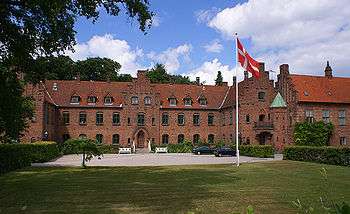St. Catherine's Priory, Roskilde

St. Catherine's Priory, Roskilde, was a priory of Dominican friars located in Roskilde. It was dissolved in the Reformation and a private house built on the site, which in 1699 became the Lutheran Roskilde Adelige Jomfrukloster (now known as Roskilde Kloster), a women's collegiate foundation.
The Dominicans established St. Catherine's Priory in Roskilde (the ancient capital of Denmark and the seat of the most important Danish diocese, the Diocese of Roskilde, or Zealand) in 1231. Source material for the Dominican priory in Roskilde is sparse, but it is clear that Roskilde ranked second only to Lund among the Dominican houses of Scandinavia during the Middle Ages. On several occasions the head of the regional order, the prior provincial, was elected from Roskilde.
Only a few of the friars are named. Friar Bo is named in a 1267 letter connected with the conflict between Archbishop Jacob Erlandsen and King Valdemar. Friar Bo was excommunicated for violating the decree of interdict laid down by the archbishop. Prior Petrus Brackæ gave all his worldly possessions to Sorø Abbey in 1312 and then became a Dominican at Roskilde. Perhaps the most famous Dominican friar of Roskilde was Johan Nyborg who was made Bishop of Roskilde in 1330.
The geatest patron of the Dominican friars of Roskilde was the immensely powerful Dowager Duchess Ingeborg (1301-c.1360), mother of King Magnus IV of Sweden and VII of Norway, who made them frequent gifts from at least 1330 onwards and also remembered them in her will.[1]
The main work of the friars was to preach and teach, so it has been supposed that a school of some sort formed part of the duties of the priory at Roskilde, perhaps in conjunction with the town's cathedral school. The Black Friars, as they were known, were a mendicant order, which means that they relied on donations to keep food on the table, candles burning, and the work of the friars. The Roskilde friars forged over time a close connection with the cathedral chapter in the city, which to an extent insulated them from the ebb and flow of events in Denmark's turbulent Middle Ages. After St. Agnes' priory for Dominican nuns was built, the friars also became responsible for the priestly functions required there.
Few details are known of the priory buildings, which were sited a little to the north of the modern Roskilde Kloster, but they consisted of a brick church consecrated to Saint Catherine in 1254, dormitory, scriptorium, refectory and a garden, which included an apple orchard. To the north of the buildings the friars owned a spring and by 1329 dams had been constructed to build at least one mill. The priory also owned at least one farm outside Roskilde, at Slagelse.
St. Agnes' Priory, Roskilde
In 1263 St. Agnes' Priory, Roskilde, a Dominican nunnery, was built north of the city outside the walls. The nuns seemed to attract more financial support than the friars, and eventually owned more than 70 farms all over Zealand which had been donated to them for maintenance and income. They also owned two bath houses in the town as additional income properties. At its height there was room for 30 nuns. King Erik Menved gave a large property including a mill to the nuns in 1295. The most famous incident relating to St. Agnes' Priory was the case of Princesses Agnes and Jutta who joined the community, endowing it with several valuable properties. When the princesses left, they took back their property and for 60 years afterwards the courts heard the complaints of the nuns' legal representatives.
Dissolution
The Reformation brought both the friary and the nunnery at Roskilde to an end. The properties of the nuns were confiscated as early as 1527. In 1532 the friary sold the farm at Slagelse because of the community's great need.
In 1536 Denmark became officially Lutheran, rejecting all Catholic institutions and most traditions. Christian III, who with many Danes opposed the constant appeal for funds by the mendicant orders, commanded the closure of the priory in 1537 and the Dominican friars were turned out. Many simply put off their habits and became residents of Roskilde. Others fled Denmark south to Germany in the search for new religious houses where they could live their lives without interference.
The friary including the church was demolished in 1557 by the town of Roskilde on direct orders from the king. The site lay vacant until 1565 when a house was built on the site by Mogens Godske, a local nobleman, which he called Sortebrødregård ("Black Brothers Farm") after the Dominicans who had occupied the site for hundreds of years. The nunnery, which had become crown property, was levelled in 1579, and the brick taken away with royal permission.
Roskilde Adelige Jomfrukloster
Godske's mansion house was enlarged several times and in 1699 was made into a Lutheran collegiate foundation for unmarried noblewomen, the Roskilde Adelige Jomfrukloster, upon the initiative of Berte Skeel. It developed into a highly prestigious institution. It was amalgamated in 1974 with an equivalent institution in Odense, the Odense Adelige Jomfrukloster, founded in 1716 by Karen Brahe, and is now known simply as Roskilde Kloster.
References
- ↑ She left them a bequest of six shillings a year to keep their lamp burning in the chancel "Roskilde". Jggj.dk.
External links
Sources
- Official website (in Danish)
- Dominican priory and nunnery, Roskilde (in Danish)
- JGGJ Danish history website: Dominican Priory and Convent at Roskilde, Denmark
Coordinates: 55°38′31″N 12°05′11″E / 55.64194°N 12.08639°E